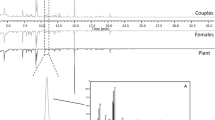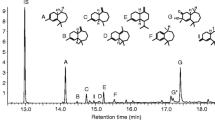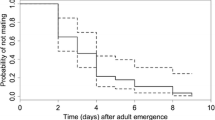Abstract
The bronze bug, Thaumastocoris peregrinus Carpintero & Dellape (Heteroptera: Thaumastocoridae), is an exotic emerging pest in Eucalyptus commercial forests in South America, Africa and southern Europe. Information on the chemical communication system and reproductive ecology of this insect is scant, and it may be relevant for designing management strategies for eucalypt plantations. Adults and nymphs usually aggregate in the field, possibly by means of chemical signals. Males emit large amounts of 3-methyl-2-butenyl butyrate, which attracts conspecific adult males but not females. The ecological role of this putative male aggregation pheromone remains unknown. Here, we report olfactometer bioassays showing that late-instar male nymphs are also attracted to synthetic 3-methyl-2-butenyl butyrate and to adult male volatile extracts, which contain this compound as the major component. As previously shown for adult females, nymphs that moulted into females were not attracted to either volatile stimulus. The intra-gender attraction of nymphs and adults may be related to the exploitation of food resources, or as a reproductive strategy for newly emerged males. Further studies on the reproductive behaviour and mating system of T. peregrinus will contribute to understanding the ecological significance of male-male, adult-nymph attraction, as well as the practical applications that may result from these findings.




Similar content being viewed by others
References
Baverstock J, Roy H, Pell J (2010) Entomopathogenic fungi and insect behaviour: from unsuspecting hosts to targeted vectors. In: Roy H, Vega F, Chandler D, Goettel M, Pell J, Wajnberg E (eds) The ecology of fungal entomopathogens. Springer, Netherlands, pp 89–102
Branco S, Videira N, Branco M, Paiva MR (2015) A review of invasive alien species impacts on eucalypt stands and citrus orchards ecosystem services: towards an integrated management approach. J Environ Manag 149:17–26. https://doi.org/10.1016/j.jenvman.2014.09.026
Carpintero DL, Dellapé PM (2006) A new species of Thaumastocoris Kirkaldy from Argentina (Heteroptera: Thaumastocoridae: Thaumastocorinae). Zootaxa 1228:61–68
Ciesla WM (2011) Forest entomology: a global perspective. Blackwell, Oxford, p 400. https://doi.org/10.1002/9781444397895
Eberhard WG (1998) Sexual behavior of Acanthocephala declivis guatemalana (Hemiptera: Coreidae) and the allometric scaling of their modified hind legs. Ann Entomol Soc Am 91(6):863–871. https://doi.org/10.1093/aesa/91.6.863
Garcia A, Figueiredo E, Valente C, Monserrat VJ, Branco M (2013) First record of Thaumastocoris peregrinus in Portugal and of the neotropical predator Hemerobius bolivari in Europe. Bull Insectol 66:251–256
González A, Calvo MV, Cal V, Hernández V, Doño F, Alves L, Gamenara D, Rossini C, Martínez G (2012) A male aggregation pheromone in the bronze bug, Thaumastocoris peregrinus (Thaumastocoridae). Psyche 2012:7
Greenfield MD (2002) Signalers and receivers: mechanisms and evolution of arthropod communication. Oxford University Press, Oxford, p 414
Harris VE, Todd JW (1980) Male-mediated aggregation of male, female and 5th instar southern green stink bugs and concomitant attraction of a tachinid parasite, Trichopoda pennipes. Entomol Exp Appl 27(2):117–126. https://doi.org/10.1111/j.1570-7458.1980.tb02955.x
Haynes KF, Millar JG (2012) Methods in chemical ecology. Volume 2: bioassay methods. Springer, United States
Higuchi H, Hiroaki N (1999) Attraction of conspecific adults and nymphs by adults of Riptortus linearis (Fabricius) (Heteroptera: Alydidae). Appl Entomol Zool 34(4):455–458. https://doi.org/10.1303/aez.34.455
Jacobs DH, Neser S (2005) Thaumastocoris australicus Kirkaldy (Heteroptera: Thaumastocoridae): a new insect arrival in South Africa, damaging to Eucalyptus trees: research in action. S Afr J Sci 101:233–236
Jolivet P (1992) Insects and plants: parallel evolution and adaptations. Sandhill Crane Press, Gainesville, FL, p 190
Khrimian A, Fay HAC, Guzman F, Chauhan K, Moore C, Aldrich JR (2012) Pheromone of the banana-spotting bug, Amblypelta lutescens lutescens Distant (Heteroptera: Coreidae): identification, synthesis, and field bioassay. Psyche 2012:8
Kochansky J, Aldrich JR, Lusby WR (1989) Synthesis and pheromonal activity of 6,10,13-trimethyl-1-tetradecanol for predatory stink bug, Stiretrus anchorago (Heteroptera: Pentatomidae). J Chem Ecol 15(6):1717–1728. https://doi.org/10.1007/BF01012260
Leal W, Higuchi H, Mizutani N, Nakamori H, Kadosawa T, Ono M (1995) Multifunctional communication in Riptortus clavatus (Heteroptera: Alydidae): conspecific nymphs and egg parasitoid Ooencyrtus nezarae use the same adult attractant pheromone as chemical cue. J Chem Ecol 21(7):973–985. https://doi.org/10.1007/BF02033802
Martínez G, López L, Cantero G, González A, Dicke M (2014) Life-history analysis of Thaumastocoris peregrinus in a newly designed mass rearing strategy. Bull Insectol 67:199–205
Martins CB, Soldi RA, Barbosa LR, Aldrich JR, Zarbin PH (2012) Volatile chemicals of adults and nymphs of the Eucalyptus pest, Thaumastocoris peregrinus (Heteroptera: Thaumastocoridae). Psyche 2012:6
Mascarin GM, Duarte VS, Brandao MM, Delalibera Jr. I (2012) Natural occurrence of Zoophthora radicans (Entomophthorales: Entomophthoraceae) on Thaumastocoris peregrinus (Heteroptera: Thaumastocoridae), an invasive pest recently found in Brazil. J Invertebr Pathol 110:401–404, 3, DOI: https://doi.org/10.1016/j.jip.2012.03.025
Millar JG (2005) Pheromones of true bugs. In: Schulz S (ed) The chemistry of pheromones and other semiochemicals II. Springer-Verlag, Berlin Heidelberg, pp 37–84
Morishima M, Tabuchi K, Ito K, Mizutani N, Moriya S (2005) Effect of feeding on the attractiveness of Riptortus clavatus (Thunberg) (Heteroptera: Alydidae) males to conspecific individuals. Jpn J Appl Entomol Zool 49(4):262–265. https://doi.org/10.1303/jjaez.2005.262
Nadel R, Wingfield M, Scholes M, Garnas J, Lawson S, Slippers B (2014) Population dynamics of Thaumastocoris peregrinus in Eucalyptus plantations of South Africa. J Pest Sci:1–10
Nadel RL, Noack AE (2012) Current understanding of the biology of Thaumastocoris peregrinus in the quest for a management strategy. Int J Pest Manage 58(3):257–266. https://doi.org/10.1080/09670874.2012.659228
Nakajima Y, Sakuma M, Sasaki R, Fujisaki K (2010) Adaptive traits of Riptortus pedestris nymphs (Heteroptera: Alydidae) for locating host plants. Ann Entomol Soc Am 103(3):439–448. https://doi.org/10.1603/AN09144
Noack AE, Cassis G, Rose HA (2011) Systematic revision of Thaumastocoris Kirkaldy (Hemiptera: Heteroptera: Thaumastocoridae). Zootaxa 3121:1–60
Paine TD, Steinbauer MJ, Lawson SA (2011) Native and exotic pests of Eucalyptus: a worldwide perspective. Annu Rev Entomol 56(1):181–201. https://doi.org/10.1146/annurev-ento-120709-144817
R Development Core (2015). R: A language and environment for statistical computing. Foundation for Statistical Computing, Vienna, https://www.R-project.org
Schoonhoven LM, Van Loon JJ, Dicke M (2005) Insect-plant biology. Oxford University Press, Oxford, p 421
Schwarz JJ, Gries G (2010) 2-Phenylethanol: context-specific aggregation or sex-attractant pheromone of Boisea rubrolineata (Heteroptera: Rhopalidae). Can Entomol 142(05):489–500. https://doi.org/10.4039/n10-027
Slater JA (1973) A contribution to the biology and taxonomy of Australian Thaumastocoridae with the description of a new species (Hemiptera: Heteroptera). Aust J Entomol 12(2):151–156. https://doi.org/10.1111/j.1440-6055.1973.tb01653.x
Speight M, Hunter M, Watt A (2008) Ecology of insects: concepts and applications. Oxford University Press, Oxford, p 628
Strong DR, Lawton JH, Southwood TRE (1984) Insects on plants—community patterns and mechanisms. Blackwell Scientific Publications, Oxford, p 313
Suma P, Nucifora S, Bella S (2014) New distribution record of the invasive bronze bug Thaumastocoris peregrinus Carpintero and Dellapé (Heteroptera, Thaumastocoridae) in Italy. EPPO Bull 44(2):179–182. https://doi.org/10.1111/epp.12122
Weber DC, Leskey TC, Cabrera Walsh G, Khrimian A (2014) Synergy of aggregation pheromone with methyl-(E,E,Z)-2,4,6-decatrienoate in attraction of Halyomorpha halys (Hemiptera: Pentatomidae). J Econ Entomol 107(3):1061–1068. https://doi.org/10.1603/EC13502
Wheeler AG Jr (1980) The mirid rectal organ: purging the literature. Fla Entomol 63(4):481–485. https://doi.org/10.2307/3494532
Zar J (2010) Biostatistical analysis. Pearson Prentice Hall International, New Jersey, p 663
Zhang QH, Aldrich JR (2003) Male-produced anti-sex pheromone in a plant bug. Naturwissenschaften 90(11):505–508. https://doi.org/10.1007/s00114-003-0466-8
Zhang QH, Chauhan K, Erbe E, Vellore A, Aldrich J (2004) Semiochemistry of the goldeneyed lacewing Chrysopa oculata: attraction of males to a male-produced pheromone. J Chem Ecol 30(9):1849–1870. https://doi.org/10.1023/B:JOEC.0000042406.76705.ab
Acknowledgments
We thank Gissel Cantero for technical assistance with insect maintenance.
Funding
This work was supported by the National Agency for Science and Innovation of Uruguay (ANII), projects FSA-2009-3133 and FSA-2013-13033. We also thank ANII for a post-doctoral fellowship to HFG.
Author information
Authors and Affiliations
Additional information
Edited by Raul Laumann – Cenargen/Embrapa
Rights and permissions
About this article
Cite this article
Calvo, M.V., Groba, H.F., Martínez, G. et al. Attraction of Male Nymphs to Adult Male Volatiles in the Bronze Bug Thaumastocoris peregrinus Carpintero & Dellape (Heteroptera: Thaumastocoridae). Neotrop Entomol 47, 835–841 (2018). https://doi.org/10.1007/s13744-017-0576-1
Received:
Accepted:
Published:
Issue Date:
DOI: https://doi.org/10.1007/s13744-017-0576-1




